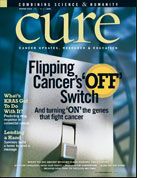Publication
Article
CURE
Out to Lunch
Author(s):
Strategies for dining out during treatment.
Dining out is a popular American pastime. But for those battling cancer, treatment-related problems such as mouth sores, sensitivity to odors, or taste alterations can make restaurant dining a challenge.
Luckily, nutrition experts say there are numerous strategies that can help cancer patients cope with these issues and get the most out of their dining experience.
“Dining out can have tremendous emotional value for cancer patients,” says Diana Dyer, RD, a dietitian in Ann Arbor, Michigan, whose own cancer experience resulted in her self-published book A Dietitian’s Cancer Story. “The company, the conversation, the connection are all important [to healing].”
Following are some simple solutions for common side effects related to surgery, chemotherapy, and radiation therapy.
Mouth sores: “Avoid foods that are harsh in terms of texture or acidity—anything that’s going to aggravate the sensitive tissues in the mouth,” advises Dyer. “Don’t hesitate to ask that dishes be made to your specification; most restaurants will be happy to accommodate you.”
Oral pain can also be reduced by applying cool, wet chamomile or green tea bags to the lesions, says Kim Dalzell, PhD, RD, author of Challenge Cancer and Win!
Mouth pain can be triggered by extremes in temperature, so consider foods that are room temperature rather than very hot or very cold.
Sensitivity to odors: Patronize restaurants that have a spacious dining room or an outdoor patio, says Dalzell. And ask that your meal be plated without a lid, which, when removed, can condense food odors and give you a noxious noseful.
Bitter taste when using metal utensils: Don’t be embarrassed to ask for or bring your own plastic tableware or even chop sticks, offers Natalie Ledesma, RD, a dietitian at the Helen Diller Family Comprehensive Cancer Center at the University of California, San Francisco. And request a glass, plastic, or ceramic cup for your beverage in lieu of a metal tumbler.
Dining out should be about the pleasure of the experience, but that doesn’t mean you should throw nutrition out the window, sources note. Cancer patients are encouraged to select nutrient-dense foods, such as fresh vegetables, fruit, and whole grains, and limit their intake of red meat and fatty foods. This is possible even in fast-food restaurants, many of which now offer more healthful selections, including salads, fruit, muffins, and yogurt.
“One of the biggest challenges when dining out is portion size,” says Dalzell. “We know that being overweight can increase cancer risk by causing the body to produce and circulate more of the hormones that stimulate cancer growth, so make sure to keep your portions small. I tell my patients to have a plan when eating out. There are going to be all kinds of obstacles and challenges in a restaurant, so you must be able to recognize them and know how to deal with them.”
Enjoy half and take the other half home for lunch or dinner the next day. But make sure to put your doggie bag in the refrigerator the moment you get home to avoid food poisoning.
Dining out can be both a reward and a first step toward a more normal life, but there are times when it is not a good idea. For example, neutropenic patients, who are more susceptible to infection as a result of their disease or its treatment, should avoid restaurants and large crowds until they receive the all-clear from their physicians. They should also be sure meals are fully cooked when ordering anything that could contain bacteria or mold.
“Enjoying a good meal in a restaurant can be empowering for someone with cancer,” says Ledesma. “What we eat is something we have control over, and that can be a strong motivation toward making good choices.”





